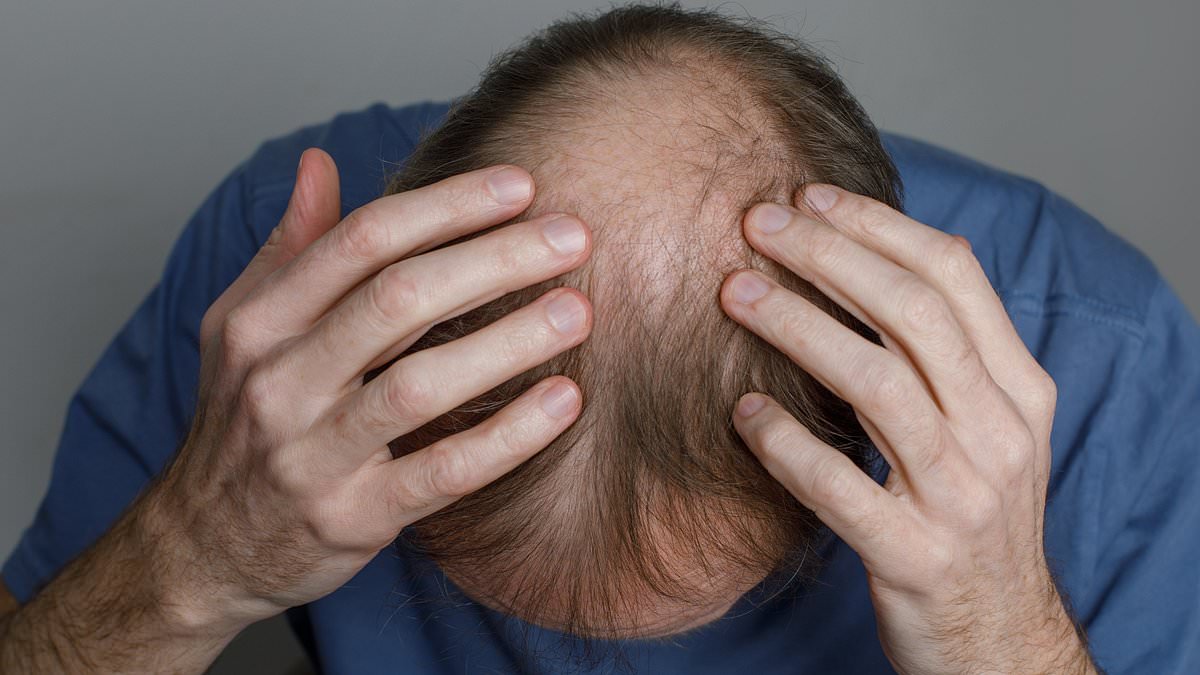Copyright dailymail

The hair loss treatment revolution: Experts reveal the scientifically proven ways to beat balding READ MORE: What your hair (or lack of!) says about you, according to scientists By WILIAM HUNTER, SCIENCE & TECHNOLOGY REPORTER Published: 12:49 GMT, 27 October 2025 | Updated: 12:49 GMT, 27 October 2025 Hair loss could soon be a thing of the past – thanks to a spate of recent scientific breakthroughs. Although some studies are only in their early stages, there are now multiple experimentally proven treatments that could spell the end for unwanted baldness. Some treatments target the underlying mechanism of balding, attempting to find the molecular 'switch' to wake up dormant hair cells. Others are aimed at making the cells in the scalp create more hair follicles when the natural ones have died away. Best of all, many of the cutting–edge treatments are cheap to produce – and quick to take effect. For example, a study last week found that a simple treatment caused impressive regrowth after just 20 days. This will likely come as a relief to the estimated 50 per cent of men and 40 per cent of women who will likely experience some level of hair loss by the time they hit 50. 'Losing hair can be upsetting. For many people, their hair is an important part of who they are,' the NHS says on its website. Going bald might one day be a thing of the past as scientific breakthroughs bring new hair loss treatments closer to becoming reality (stock image) Baldness is often regarded as an issue affecting men. However, studies have shown that hair loss actually affects roughly 50 million men and 30 million women in the US alone. That has created a booming industry for hair loss treatments, with an estimated value of $7.6 billion (£5.7bn) in 2020, and expected to rise to $13 billion (£9.7bn) by 2028. With huge potential profits on the line, labs all around the world are racing to be the first to deliver a genuine cure for baldness. Some of the most promising potential treatments involve naturally derived plant extracts. While chemical treatments such as minoxidil and finasteride are commercially available, these can cause nasty side effects ranging from depression to sexual dysfunction. Researchers are hoping they can find a natural alternative that has all of the benefits and none of the drawbacks. In October, researchers at the Schweitzer Biotech Company in Taiwan released results from a promising treatment containing an extract from the Centella asiatica plant. Scientists have tested a treatment containing an extract of the Centella asiatica plant on humans. These before (left) and after (right) pictures show how it has restored thickness after two months The key ingredient of this potential treatment is an extract from the tropical plant Centella asiatica (pictured), which is known for its anti–ageing, restorative, and anti–inflammatory uses The most promising treatments for hair loss Centella extract: Results after two months in humans Phellodendron and Chinpi extract: Results in lab–grown human cells 2–deoxy–D–ribose: Results after 20 days in mice Fatty acids: Results in 20 days in mice and anecdotal evidence of success in humans Stem cells and ATP: Results after 21 days in mice Advertisement The scientists combined caffeine (a common ingredient in hair loss shampoo), two proteins known to stimulate cell growth, and these plant extracts. After just two months of daily use, participants receiving this treatment saw their hair density increase by 23.9 per cent. Likewise, their average hair thickness increased by 27.9 micrometres, compared to just 13.9 micrometres in the placebo group. This was particularly exciting since the study was conducted on human participants, who saw real benefits from using the treatment. Meanwhile, researchers in Japan have identified two plants which could be the basis of a promising hair loss treatment. These are Phellodendron bark, a thick bark found in tropical parts of Asia, and chinpi, which is a type of sun–dried mandarin orange peel. In order to promote hair growth, the researchers decided to focus on a natural protein produced by the dermal papilla cells called Placental Growth Factor (PlGF). This protein is known to play an important role in the formation of hair at the bottom of the hair follicle, so the scientists wanted to see if they could stimulate its secretion. Researchers in Japan have pinpointed two plant extracts that appear to boost hair growth – chinpi and phellodendron bark. Both have been shown to promote the secretion of proteins that trigger hair growth Both chinpi and phellodendron bark trigger the secretion of Placental Growth Factor (PlGF), a protein produced by dermal papilla cells that is known to play an important role in the formation of hair at the bottom of the hair follicle Testing on lab–grown human cells, extracts of Phellodendron Bark and chinpi boosted PIGF production by 2.1 and 2.2 times, respectively. Although this treatment is a way off testing in humans, it presents a possible alternative pathway towards fighting baldness. Instead of looking at natural plant extracts, other researchers have focused on natural proteins and processes within the body. Several studies have already had some success with this approach in mice. For example, in one study, researchers found that a sugar which naturally forms in our bodies was just as good as Rogaine at promoting hair growth after 20 days. The sugar, known as 2–deoxy–D–ribose (2dDR), promotes the growth of blood vessels near the surface, which can help boost tired hair follicles. Another group of researchers have focused on a protein called MCL–1, which plays a key role in hair growth and follicle protection. Hair follicles, once developed, go through regular cycles of dormancy and growth. Around 70–90 per cent of our scalp hairs stay in the growth phase, but certain conditions can disrupt this, leading to hair loss. Another promising avenue of research is the MCL–1 protein. When this protein was blocked, mice lost their hair after 30 days. Scientists think this could help develop treatments that prevent baldness from occurring The MCL–1 protein appears to play a critical role in the growth phase but – just as importantly – it can help 'calm' follicle stem cells when they 'reawaken' from inactivity. This can prevent the hair follicles from becoming too stressed, which causes damage and prevents regeneration. In the study, mice that had their MCL–1 production blocked lost their hair over the next 90 days. However, one recent study has already shown promising results in human testing, albeit on a small scale. Researchers at National Taiwan University had realised that skin irritation promotes excess hair growth when damaged fat cells release fatty acids that are absorbed by hair follicles. The experts wanted to see the effect of fatty acids on skin without the use of any chemical irritant, so they created serums made of different fatty acids dissolved in alcohol, such as oleic acids and palmitoleic acids. In testing on mice, the treatment showed rapid hair regrowth after just 20 days. What's more, lead researcher Professor Sung–Jan Lin also revealed that he had been testing a version of the ointment on his own thighs and had found that it promoted hair regrowth. Researchers from Taiwan treated mice with serums made of different fatty acids dissolved in alcohol, such as oleic acids and palmitoleic acids. After just 20 days, these promoted the development of new hair follicles in the skin The researchers believe this could be available as an over–the–counter treatment for hair loss within the next few years. The final type of promising hair loss cure is those which aim to manipulate the cells in the scalp directly. In July, experts at Hospital Clínico San Carlos in Madrid showed they could grow hair on male and female mice using stem cells. Stem cells are an important type of cell which has the capacity to regenerate and transform into different types of cells. In lab experiments, bald mice were injected with stem cells mixed with adenosine triphosphate (ATP), a compound that provides energy to cells. Lead author Dr López Bran said in a statement: 'The mix stimulates hair regeneration by combining the regenerative capacity of the former with the energy provided by the latter.' While results were minimal for the first seven days, after three weeks, some of the rodents' coats had been restored to full thickness. Researchers also found that the experimental group had greater hair follicle density and bulb diameter, which can result in greater thickness of the hair strand and, in turn, stronger hair. Other researchers have attempted to turn back hair loss using stem cells. A chemical cocktail containing stem cells and denosine triphosphate (ATP) effectively reversed baldness in the majority of the rodents after 21 days These microscopic images show skin samples from mice treated with stem cells (right) and those which were not treated (left). The experimental group showed greater hair follicle density and bulb diameter Scientists find simple way to cure hair loss - as trials in mice reveal regrowth after 20 days Dr Bran and his co–authors think it might take time to get approval for the treatment, but say it could be available to the public as early as 2029. He says: 'In the future, we will be able to offer new solutions that allow us to meet patients' expectations.' Currently, none of these potential treatments are close to obtaining regulatory approval or being released to the public. However, experts are increasingly confident that a breakthrough could soon pave the way for a commercial baldness cure. What are the causes of hair loss? It is perfectly normal for people to lose small amounts of hair as it replenishes itself and, on average, people can shed between 50 and 100 hairs per day. However, if people start to lose entire patches of hair or large amounts of it it can be more distressing and potentially a sign of something serious. Pattern baldness is a common cause of hair loss as people grow older. At least half of men over the age of 50 will lose some of their hair just through the ageing process, according to the British Association of Dermatologists. Women may lose their hair as they grow older, too. Other, more concerning causes of hair loss include stress, cancer treatment such as chemotherapy or radiotherapy, weight loss or an iron deficiency. Most hair loss is temporary, however, and can be expected to grow back. Specific medical conditions which cause the hair to fall out include alopecia, a disorder of the immune system; an underactive or overactive thyroid; the skin condition lichen planus or Hodgkin's lymphoma, a type of cancer. People should visit their doctor if their hair starts to fall out in lumps, falls out suddenly, if their scalp itches or burns, and if hair loss is causing them severe stress. AsiaNHSJapan Share or comment on this article: The hair loss treatment revolution: Experts reveal the scientifically proven ways to beat balding Add comment



